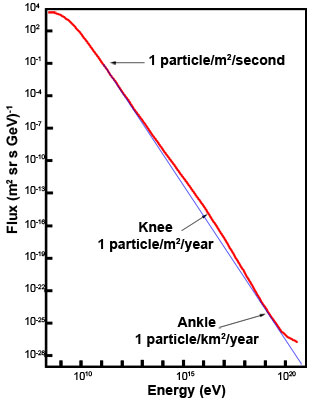Cosmic Rays
Cosmic ray fluxes, consisting of completely ionized atomic nuclei originating outside the solar system and accelerated to very high energies, provided average dose rates of 1.0 millirads per hour in cislunar space** and 0.6 millirads per hour on the lunar surface. These values are expected to double at the low point in the 11-year cycle of solar-flare activity (solar minimum) because of decreased solar magnetic shielding of the central planets. The effect of high-energy cosmic rays on humans is unknown but is considered by most authorities not to be of serious concern for exposures of less than a few years. Experimental evidence of the effects of these radiations is dependent on the development of highly advanced particle accelerators or the advent of long-term manned missions outside the Earth's geomagnetic influence.
Source: https://history.nasa.gov/SP-368/s2ch3.htm
This is not the whole story.
Again, you show that you don't understand the physics, and in particular you don't understand why a particular measured dose to an UNPROTECTED body differs from that which might be suffered by a shielded body
 The cosmic ray spectrum clearly shows that the number of cosmic rays (the cosmic ray flux) detected drops off dramatically as we go to higher energies. The spectrum exhibits a ‘knee’ and an ‘ankle’, both of which deviate from the standard exponential decline (blue line).
The cosmic ray spectrum clearly shows that the number of cosmic rays (the cosmic ray flux) detected drops off dramatically as we go to higher energies. The spectrum exhibits a ‘knee’ and an ‘ankle’, both of which deviate from the standard exponential decline (blue line).
The range of energies encompassed by cosmic rays is truly enormous, starting at about 107 eV and reaching 1020 eV for the most energetic cosmic ray ever detected. By plotting this range of energies against the number of cosmic rays detected at each energy we generate a cosmic ray spectrum which clearly shows that the number of cosmic rays drop off dramatically as we go to higher energies.
Roughly speaking, for every 10% increase in energy beyond 109 eV, the number of cosmic rays per unit area falls by a factor of 1,000. However, if we look at the spectrum more closely we can see a knee at ~ 1015 eV and an ankle at ~ 1018 eV.http://astronomy.swin.edu.au/cosmos/C/Cosmic+Ray+EnergiesLet me try to put this is layman's terms for you., since you seem to not understand
Imagine that you have to go into an area (in order to perform some task) where there are 10,000 people shooting with shotguns from some distance; not close enough to blow a hole in you, but far enough away so that you will be constantly showered with pellets. However, in among those shooters are a some people armed with .22 cal rifles each firing one round per minute, a couple with a 7.62 mm rifle who will shoot once every 10 minutes, and finally a shooter armed with a 20mm cannon, who will be firing once per hour.. None of these shooters are actually aiming at you, but they are shooting in the general direction of where you are going to be.
What these shooters will be firing at you represents a spectrum of missiles.... at the less dangerous end of the spectrum are the shotgun pellets, huge numbers and frequency, and at the more dangerous end, the 20mm cannon; far more dangerous but far less frequent.
If you go in unprotected, the shotgun pellets will do you serious damage
If you wear minimal protection, say, heavy leather coveralls, they will protect you from the shotgun pellets but not from anything else
If you wear a lightweight bullet proof vest, it will protect you from the pellets and the 22 cal.
If you go for full Kevlar body armour, that will protect you from everything except the 20mm cannon.
If you wear a suit made of one inch armour plate, it will protect you from the 20mm cannon.
You may choose the full protection, but that is going to compromise your ability to carry out whatever task you need to carry out.
The Apollo missions (and indeed all space missions) are designed and built such that shielding is incorporated into design. This protects the spacecraft (and its occupants) from the vast majority of the radiation (the shotgun pellets, and possibly, the .22 cal). The exposure to the higher end particles (the 7.62 and the 20mm cannon) is the risk they take, but even then, there are procedures put in place to use the existing shielding to help with protection, such as, in the case of a CME, orienting the spacecraft to put the maximum amount of its mass between the crew and the Sun. (not sure of the was a plan on Apollo, I'll leave other more knowledgeable people to answer that)